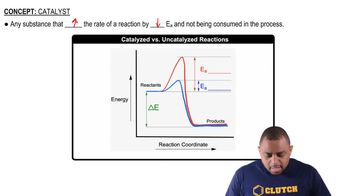Here are the essential concepts you must grasp in order to answer the question correctly.
Reaction Rate
The reaction rate refers to the speed at which reactants are converted into products in a chemical reaction. It is influenced by various factors, including the concentration of reactants, temperature, and the presence of catalysts. In this case, the rate is directly proportional to the concentration of B2 and substance C, indicating that these species play a significant role in determining how quickly the reaction occurs.
Recommended video:
Catalysts
A catalyst is a substance that increases the rate of a chemical reaction without being consumed in the process. It provides an alternative pathway for the reaction with a lower activation energy. In the context of this question, substance C may act as a catalyst, facilitating the reaction between A and B2, which explains its influence on the reaction rate without appearing in the overall balanced equation.
Recommended video:
Catalyzed vs. Uncatalyzed Reactions
Chemical Equations
Chemical equations represent the reactants and products of a reaction, showing their stoichiometric relationships. Not all substances involved in a reaction are included in the balanced equation; intermediates or catalysts may not appear because they do not change the overall composition of the reactants and products. This is why substance C, while affecting the reaction rate, does not appear in the final equation for the reaction.
Recommended video:
Balancing Chemical Equations




